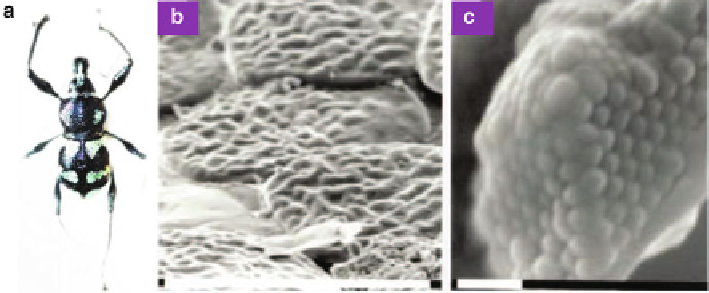Biomedical Engineering Reference
In-Depth Information
Fig. 8.31
(
a
) Photograph of the weevil
P. argus
.(
b
) SEM image showing several partially
overlapping scales. (
c
) Cross-sectional SEM image of a region of a scale. Scale bars: (
b
) 100
mand(
c
)1
m (Reproduced from [
126
])
8.5.4.2
3D Photonic Crystal
In addition to 2D photonic crystals, 3D photonic crystals that are periodic in
three dimensions are also present in the biological world. Revealed 3D photonic
crystals display various forms exhibiting different optical effects. Unlike 1D and 2D
photonic structures, the determination of the detailed structural configurations for
3D photonic structures is rather difficult and challenging, especially for those with
complicated connectivity and topology. This is because commonly used electron
microscopy such as SEM and TEM can only offer 2D structural information for
certain sectioned orientations. Electron tomography could be very helpful in the
reconstructions of 3D photonic structures. The correct determination of complex 3D
photonic structures are, however, still a difficult task even with electron tomography.
As a result, one has to be very careful in the recognition and reconstruction when
based on a few 2D SEM or TEM sectioned images.
The first 3D photonic crystal revealed in the biological world might be the one
in the scales of the weevil
Pachyrhynchus argus
[
126
],asshowninFig.
8.31
.The
weevil displays a metallic color coming from the scales, about 0.1 mm in diameter,
occurring in the patches on the top and sides of its body. The scales are flat, lying
parallel to the body. The colored scales show a yellow-green color in reflected light
and a complementary purple color in transmitted light from most directions. These
colored scales consist of an outer shell and an inner part. The inner part is an array of
transparent spheres, each with a diameter of 250 nm, arranged in the close-packing
order. This arrangement is similar to that in opal, i.e., spheres that are arranged in a
face-centered cubic lattice. The invariant yellow-green color perceived is a result of
global averaging of different domains since the scales contain differently oriented
domains of opal-like structures. Moreover, iridescence is absent due to the averaging
effects, leading to nearly the same bright coloration from every direction. This could
be useful for interspecific color or pattern recognition.

